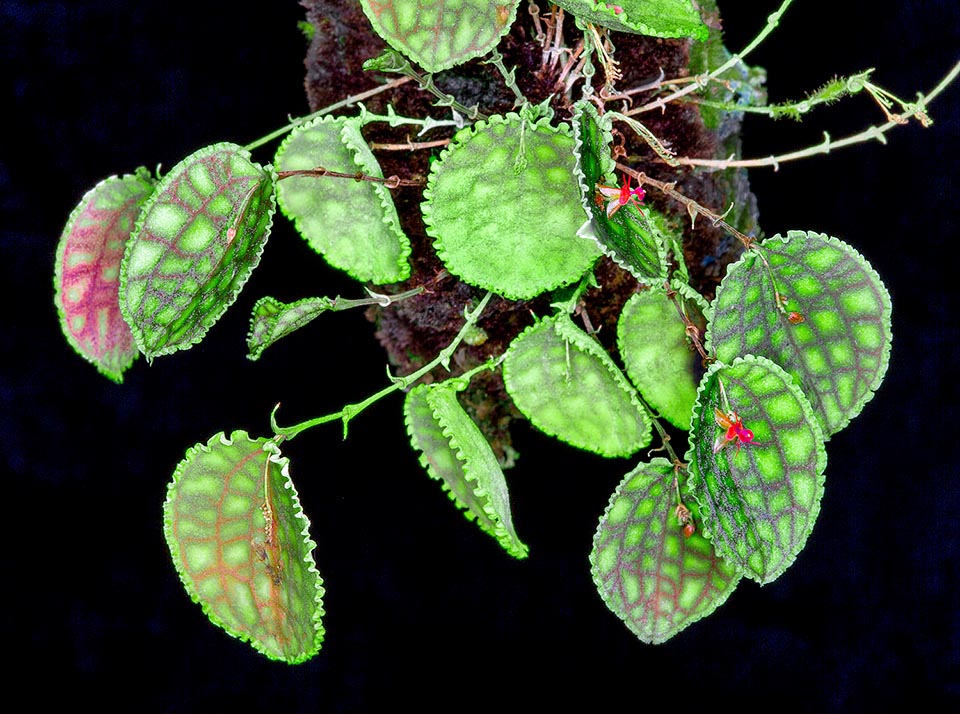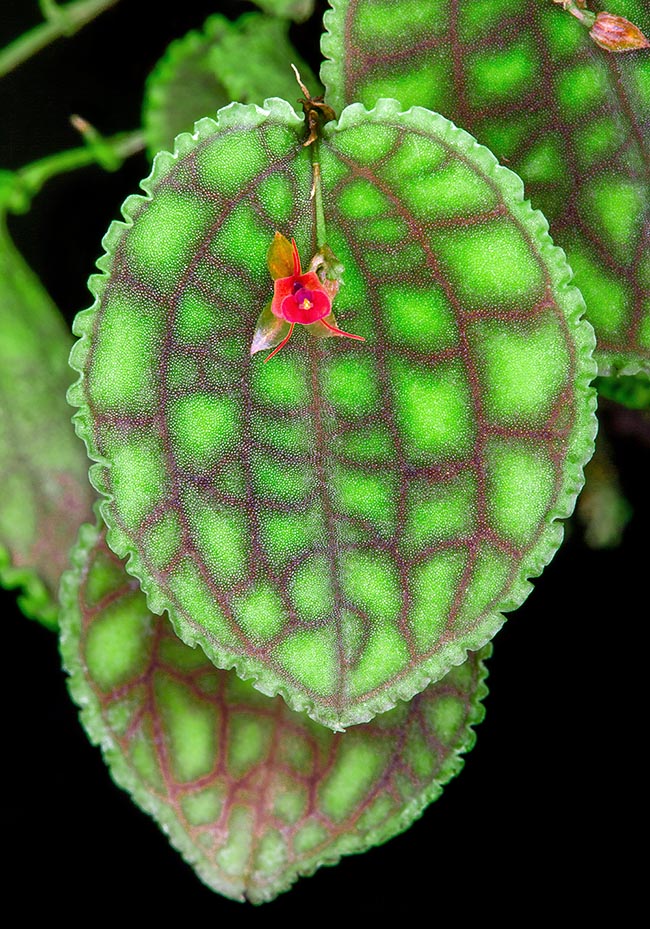Family : Orchidaceae

Text © Pietro Puccio

English translation by Mario Beltramini
The species is native to Colombia and Ecuador where it grows on the trees of the humid forests in the western Andean Cordillera, between the 450 and the 1400 m of altitude.
The etymology of the generic name has not been specified by the author, after some it is the combination of the Greek substantives “λεπίς” (lepis) = scale and “άνθος” (anthos) = flower, with reference to the shape of the flower of many species. Others believe it comes from “λέπος” (lepos) = bark and “άνθος” (anthos) = flower, seen that the plants of the genus live on the bark of the trees. The specific name is the combination of the Greek adjective “καλός” (kalós) = beautiful and of the substantive “δίκτυον” (dictyon) = net, with reference to the pattern of the veins on the leaves.

Native to Colombia and Ecuador, Lepanthes calodictyon is an epiphyte of the Andean Cordillera. Mini orchid that forms dense tufts with 1,5-2,5 cm very decorative leaves © Giuseppe Mazza
The Lepanthes calodictyon Hook. (1861) is an epiphyte species with short rhizome and thin erect stems, 2-5 cm tall, covered by sheaths ending with an ovate-acuminate infundibuliform expansion with ciliated margin. The stems are provided at the apex of an ovate leaf with obtuse or apiculate apex and sinuate-crenate wavy margin, of pale green colour with brown veins, 1,5-2,5 cm long and 0,8-2 cm broad.
Axillar racemose inflorescences, on short peduncle, solitary or fasciculate, 2-3 cm long, bearing 15-18 tiny short lasting flowers, some day, but produced in succession.

The tiny few millimetres flowers, similar to insects, open in succession © Giuseppe Mazza
Ovate free sepals with acuminate apex of greenish colour, 2-3 mm long and 1-2 mm broad. Chordate-reniform petals with acute apex, ciliate margin and filiform appendages at the base on both sides, of orange red colour, 2-3 mm long and about 1 mm broad. Spatulate labellum with ciliate margin, erect, of purple red colour, 1-2 mm long.
It reproduces by seed, in vitro, and by division, with each section provided of at least 3-4 stems.
Mini orchid forming dense tufts with leaves among the most decorative of the family and tiny flowers similar to insects, it requires high luminosity, but not direct sun, excepting possibly in the first hours of the morning in winter.
Intermediate temperatures, with lowest night winter temperatures not under the 16 °C and highest summer ones preferably not over the 30 °C, constantly high humidity, not having reserve organs, over the 70 %, and continuous slight ventilation.
It can be mounted on bark or raft of cork or of roots of arborescent ferns, with sphagnum at the base to maintain the humidity, or cultivated in small pots with draining compost that may be formed by finely sliced bark fragments, charcoal and inerts with addition of sphagnum.
Watering must be regular all over the year, as it does not have a rest period, in order to maintain constantly humid the substratum, but without stagnations, that may cause rottenness, daily for the mounted plants, utilizing rain water, by reverse osmosis or demineralized.
Monthly fertilizations with balanced hydro-soluble product at ¼ of the suggested dosage. The ideal environment of cultivation is a intermediate humid greenhouse or a terrarium where it is possible to adjust properly all the environmental parametres.
In the apartment, it can be placed behind a window facing east, with humidifier to maintain a high humidity level or resorting to the classical system of placing the plant on an ample saucer filled up of crushed stone or expanded clay, with a layer of water not in direct contact with the bottom of the pot.
The species is inscribed in the appendix II of the CITES (species whose trade is internationally ruled).
Synonyms: Stelis calodyction Spruce (1862); Lepanthes calodictyon f. ivanoflava O.Gruss (2011).
